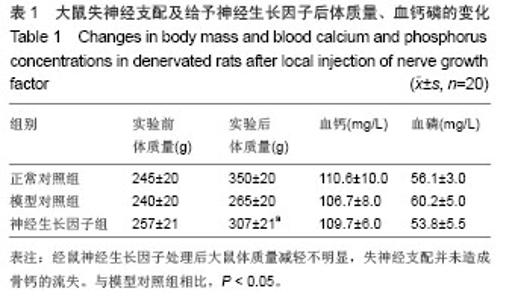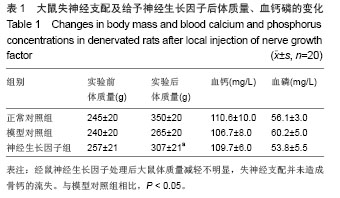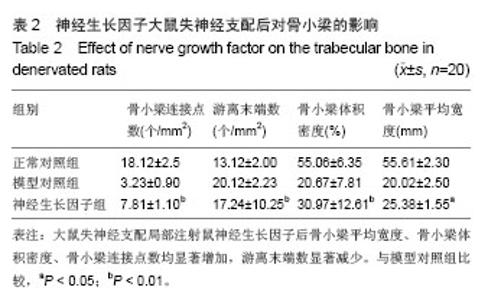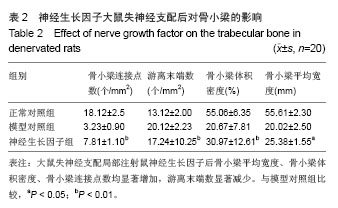| [1]Morley J, Marsh S, Drakoulakis E.Does traumatic brain injury result in accelerated fracture healing. Injury.2005; 36(3): 363-368.
[2]王小健,苏云星,余建平,等.感觉/运动神经切断影响大鼠骨折愈合的实验研究[J].中国矫形外科杂志,2008,16(6):450-454.
[3]Otfinowski J. Heterotopic induction of osteogenesis in the couse of neural injury. Patol Pol.1993;44(1):133-168.
[4]Offley SC, Guo TZ, Wei T. Capsaicin-sensitive sensory neurons contribute to the maintenance of trabecular bone integrity. J Bone Miner Res. 2005;20(2):257-267.
[5]Eflefteriou F.Regulation of bone remodeling by the central and peripheral nervous system. Arch Biochem Biophys. 2008;473(2):231-236.
[6]Osen CJ.Bone remodeling, energy metabolism, and the molecular clock. Cell Metab. 2008;7(1):7-10.
[7]Saadoun S, Bell BA, Verkman AS, et al.Greatly improved neurological outcome after spinal cord compression injury in AQP4-deficient mice.Brain.2008;131(4):1087-1098.
[8]Yamaguchi M, Fukagawa M.Role of zinc in regulation ofprotein tyrosine phosphatase activity in osteoblastic MC3T3-E1 cells: zinc modulation of insulin-like growth factor-I's effect. Calcif Tissue Int.2005;76(1):32-38.
[9]Liang D, Yang M, Guo B, et al.Zinc Upregulates the Expression of Osteoprotegerin in Mouse Osteoblasts MC3T3-E1 Through PKC/MAPK Pathways.Biol Trace Elem Res.2012;146:340-348.
[10]Guo B, Yang M, Liang D,et al.Cell apoptosis induced by zinc deficiency in osteoblastic MC3T3-E1cells via a mitochondrial- mediated pathway.Mol Cell Biochem. 2012; 361(1-2):209-216.
[11]Alexandrino AP, Rodrigues MA, Matsuo T,et al.Evaluation of seminal zinc levels by atomic absorption in men with spinal cord injury.Spinal Cord.2011;49(3):435-438.
[12]Wang Y, Me X, Zhang L,et al.Supplement moderate zinc as an effective treatment for spinal cord injury. Med Hypotheses. 2011;77(4):589-590.
[13]陈毅军,赵小纲.神经损伤影响骨折愈合速度机制研究的进展[J].创伤外科杂志,2008,10(1):79-81.
[14]朱建平,张伯勋,刘郑生,等.选择性神经根损伤对大鼠骨代谢影响的实验研究[J].中国矫形外科杂志,2002,9(4):354-356.
[15]Gautschi OP, Toffoli AM, Joesbury KA, et al.Osteoinductive effect of cerebrospinal fluid from brain-injured patients. Neurotrauma. 2007;24(1):154-162.
[16]王玉国,张丹丹.鼠神经生长因子治疗视神经挫伤的研究[J].航空航天医药,2010,21(4):435-436.
[17]杨惠婷,姚鹏,李静秋.视神经钝挫伤的诊治及疗效观察[J].牡丹江医学院学报,2012,33(5):50-52.
[18]张丹丹.鼠神经生长因子结合葛根素对视神经挫伤治疗效果的研究[D].哈尔滨:黑龙江中医药大学,2010.
[19]Lazo MG, Shirazi P, Sam M, et al. Osteoporosis and risk of fracture in men with spinal cord injury. Spinal Cord. 2001;39(4):208-214.
[20]Zhao L, Lv GM, Jiang SY, et al,Donglin Jiang. Morphological differences in skeletal muscle atrophy of rats with motor nerve and/or sensory nerve injury. Neural Regen Res. 2012; 7(32): 2507-2515.
[21]Modlesky CM, Majumdar S, Narasimhan A et al. Trabecular bone microarchit ecture is deteriorated in men with spinal cord injury. J Bone Miner Res.2004;19 (1):48-55.
[22]Vestergaard P, Krogh K, Rejnmark L, et al. Fracture rates and risk factors for fractures in patients with spinal cord injury. Spinal Cord.1998; 36(11): 790-796.
[23]沈凌飞,胡美君.复方樟柳碱联合鼠神经生长因子治疗视神经挫伤疗效分析[J].求医问药:下半月,2011,9(2): 73-74.
[24]陈迎月,郑帆,陈勤.复方樟柳碱联合鼠神经生长因子治疗视神经挫伤的临床观察[J].海峡药学,2011,23(9):102-103.
[25]龚善初,邱久军,李东,等.注射用鼠神经生长因子治疗儿童孤独症的疗效观察[J].中国药业,2012,21 (22): 40-42.
[26]张旭,杨丽娟,陆金梅.鼠神经生长因子治疗视神经萎缩的临床观察[J].中国临床研究,2010,23(6):463-464.
[27]魏智慧,高海雷.腰麻硬膜外联合麻醉致脊髓损伤一例反思[J].临床误诊误治,2010,23(1):79.
[28]高建平,王健,张来虎.胸腰椎骨折合并脊髓损伤的早期手术治疗[J].中国当代医药,2012,19( 33):190-192.
[29]王印国,韦国强,陈娟.鼠神经生长因子治疗急性一氧化碳中毒迟发性脑病临床观察[J].华北国防医药,2010,22(3):227.
[30]Garland DE, Adkins RH, Stewart CA, et al. Regional osteoporosis in women who have a complete spinal cord injury. J Bone Joint Surg Am.2001;83(8):1195-1200.
[31]Warden SJ, Bennell KL, Matthews B, et al.Quantitative ultrasound assessment of acute bone loss following spinal cord injury: a longitudinal pilot study. Osteoporos Int.2002; 13(7):586-592.
[32]Savignat M, De-Doncker L, Vodouhe C, et al. Rat nerve
regeneration with the use of a polymeric membrane loaded with NGF.J Dent Res.2007;86(11):1051-1056.
[33]Amino S, Itakura M, Ohnsi H, et al. Nerve growth factor
enhances neurotransmitterrelease from PC 12 cells by increasing Ca2+-responsible secretory vesicles through the activation of mitogen-activated protein kinase and hosphatidy linositol 3-kinase.J Biochem.2002;131(6):887-894.
[34]Kim HC, Cho YJ, Ahn CW, et al . Nerve growth factor and
expression of itsreceptors inpatients with diabetic europathy.Diabet Med.2009;26(12):1228-1234.
[35]Li XL,Zhang W,Zhou X,et al.Temporal changes in the expression of some neurotrophins in spinal cord transected adult rats.Neuropaptides.2007; 41(3):135-143.
[36]Kasahara K,Nakagawa T,Kubota T.Neuronal loss and expression of neumtrophic factors in a model of rat chronic compressive spinal cord injury.Spine.2006;31(18): 2059-2066.
[37]Sharma HS.A select combination of neurotrophins enhances neu-oprotection and functional recovery following spinal cord injur.Ann N Y A cad Sci. 2007;11(22):95-11.
[38]Swoboda KJ,Kissel JT,Crawford TO,et al.Perspectives on clinical trials in spinal muscular atrophy.J Child Neurol.2007;22(8):957-966.
[39]Wang Y, Zhang H, Wang Z, et al. Therapeutic effect of nerve growth factor on cerebral infarction in dogs using the hemisphere anomalous volume ratio of diffusion-weighted magnetic resonance imaging. Neural Regen Res. 2012; 7(24): 1873-1880.
[40]Sunderland S,Beeadly KC.Stress-strain phenomenia in human peripheral never trunks.Brain.1961;84(2):102.
[41]Yu Y,M atsuyam a Y,Nakashim a S,et al.Effects of M PSS and a potent iNOS inhibitor on traumatic spinal cord injury.Neuroreport.2004;15(13):2103-2107.
[42]Gerndt SJ,Rodriguez L,Pawlik JW,et al. Consequences of high-dose steroid therapy for acute spinal cord injury.J Trauma.1997;42(2):279-284.
[43]Haghighi SS,Agrawal SK,Surdell D Ir,et al.Efects of methylprednisolone and MK-801 on functional recovery after experimental chronic spinal cord injury.Spinal Cord.2000; 38(12):733-740.
[44]Chen ZY,Chai YF,Cao L,et al.G1ial cell line-derived neurotrophic factor enhances axonal regeneration following sciatic nerve transaction in adult rats.Brain Res.2001;902(2):272-276.
[45]Kasai Y, Iida R, Uchida A. Metal concentrations in the serum and hair of patients with titanium alloy spinal implants. Spine. 2003;28:1320-1326.
[46]Ma SZ, Peng CL, Wu SQ, et al. Sciatic nerve regeneration using a nerve growth factor-containing fibrin glue membrane. Neural Regen Res. 2013; 8(36): 3416-3422.
[47]Closkey RW, Parsons JR,Blacksin MF,et al. Mechanics of interbody spinal fusion:analysis of critical bone graft area. Spine.1993,18:1011.
[48]Adam C,Pearcy M,McCombe P. Stress analysis of interbody fusion--finite element modelling of intervertebral implant and vertebral body. Clin Biomech (Bristol, Avon). 2003;18(4): 265-272. |



